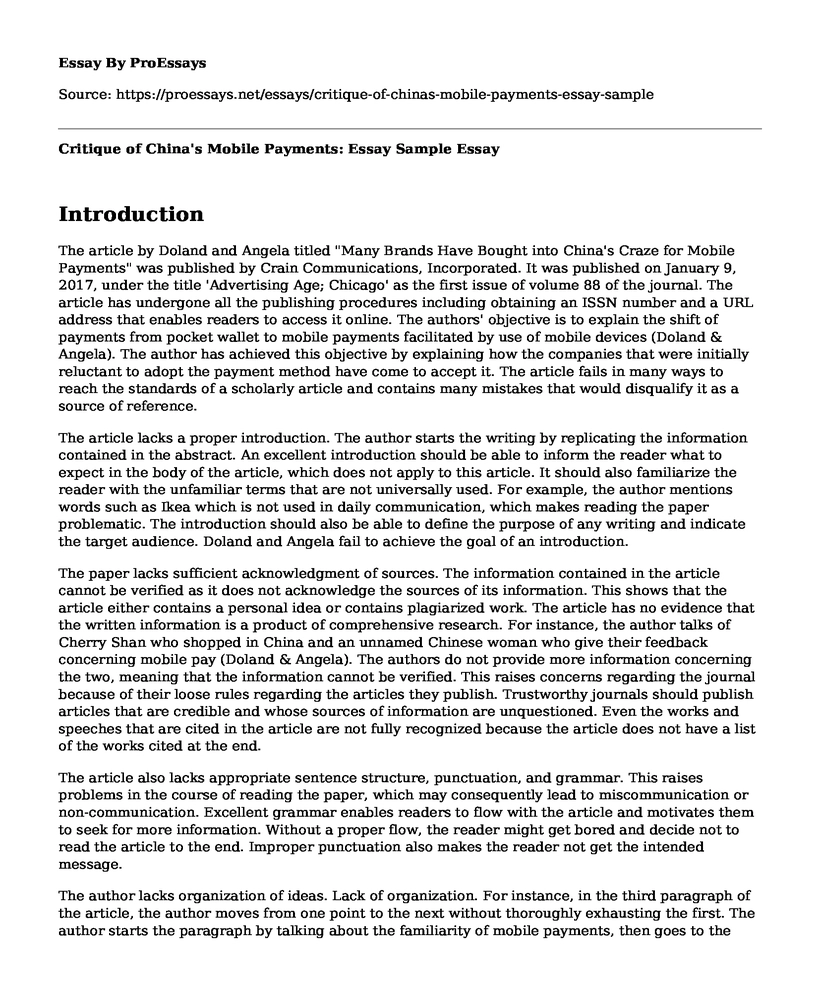Introduction
The article by Doland and Angela titled "Many Brands Have Bought into China's Craze for Mobile Payments" was published by Crain Communications, Incorporated. It was published on January 9, 2017, under the title 'Advertising Age; Chicago' as the first issue of volume 88 of the journal. The article has undergone all the publishing procedures including obtaining an ISSN number and a URL address that enables readers to access it online. The authors' objective is to explain the shift of payments from pocket wallet to mobile payments facilitated by use of mobile devices (Doland & Angela). The author has achieved this objective by explaining how the companies that were initially reluctant to adopt the payment method have come to accept it. The article fails in many ways to reach the standards of a scholarly article and contains many mistakes that would disqualify it as a source of reference.
The article lacks a proper introduction. The author starts the writing by replicating the information contained in the abstract. An excellent introduction should be able to inform the reader what to expect in the body of the article, which does not apply to this article. It should also familiarize the reader with the unfamiliar terms that are not universally used. For example, the author mentions words such as Ikea which is not used in daily communication, which makes reading the paper problematic. The introduction should also be able to define the purpose of any writing and indicate the target audience. Doland and Angela fail to achieve the goal of an introduction.
The paper lacks sufficient acknowledgment of sources. The information contained in the article cannot be verified as it does not acknowledge the sources of its information. This shows that the article either contains a personal idea or contains plagiarized work. The article has no evidence that the written information is a product of comprehensive research. For instance, the author talks of Cherry Shan who shopped in China and an unnamed Chinese woman who give their feedback concerning mobile pay (Doland & Angela). The authors do not provide more information concerning the two, meaning that the information cannot be verified. This raises concerns regarding the journal because of their loose rules regarding the articles they publish. Trustworthy journals should publish articles that are credible and whose sources of information are unquestioned. Even the works and speeches that are cited in the article are not fully recognized because the article does not have a list of the works cited at the end.
The article also lacks appropriate sentence structure, punctuation, and grammar. This raises problems in the course of reading the paper, which may consequently lead to miscommunication or non-communication. Excellent grammar enables readers to flow with the article and motivates them to seek for more information. Without a proper flow, the reader might get bored and decide not to read the article to the end. Improper punctuation also makes the reader not get the intended message.
The author lacks organization of ideas. Lack of organization. For instance, in the third paragraph of the article, the author moves from one point to the next without thoroughly exhausting the first. The author starts the paragraph by talking about the familiarity of mobile payments, then goes to the Ikea and later mentions Ad Age's questions which have not been earlier introduced. Critical analysis of the third paragraph shows that no single point has been exhaustively discussed.
The paragraphs lack a good transition. The author moves from one paragraph without giving it a conclusion and moves to an entirely new point in the next paragraph, leaving the reader hanging and not informed what the previous point was supposed to mean. The non-interconnectedness of paragraphs discourages the readers because they end up only reading and not getting the message. Some paragraphs only contain a single sentence and others are just a non-punctuated phrase. For instance, towards the end of the first page, the statement "Where mobile is king" (Doland & Angela), is not clear whether it is meant to be a continuation of the previous paragraph, a heading or an independent paragraph.
The target audience of the article is not clear. The article does not seem to serve any scholarly purposes; thus it cannot be used by scholars as a point of reference. The information also cannot be used by policymakers because the few recognized sources are people's ideas and it lacks credible sources. The paper, therefore, lacks a definite purpose.
The article also lacks a conclusion. A conclusion is vital in scholarly and business articles because it summarizes the ideas discussed in the body and gives a recommendation or a way forward. The authors of Advertising Age seem to put down points without really knowing their importance, a factor that makes them unable to conclude.
Conclusion
The article lacks credibility to be used as a point of reference for scholars, researchers, and policymakers. Lack of credibility is brought about by the disorganization of the paper exhibited from the introduction through the body to the conclusion.
Work Cited
Doland & Angela, "Many Brands Have Bought into China's Craze for Mobile Payments." Advertising Age; 88.1 (2017): 1-3.
Cite this page
Critique of China's Mobile Payments: Essay Sample. (2022, Apr 07). Retrieved from https://proessays.net/essays/critique-of-chinas-mobile-payments-essay-sample
If you are the original author of this essay and no longer wish to have it published on the ProEssays website, please click below to request its removal:
- Three Ways in Which Public Health England (PHE) Attempts to Minimize Inequalities in Health
- Network History: CNBC Company Paper Example
- Calculating Present and Future Cash Flows Essay
- Current Structure of the Australian Banking Industry Paper Example
- Paper Example on Managing Money: Financial Management, Investments & Cash Flow Analysis
- Paper Example on Cyber Intrusion Hits US Office of Personnel Management: 2 Attacks Detected
- Essay Sample on Lower Interest Rates: How Expansionary Monetary Policy Stimulates Economy







